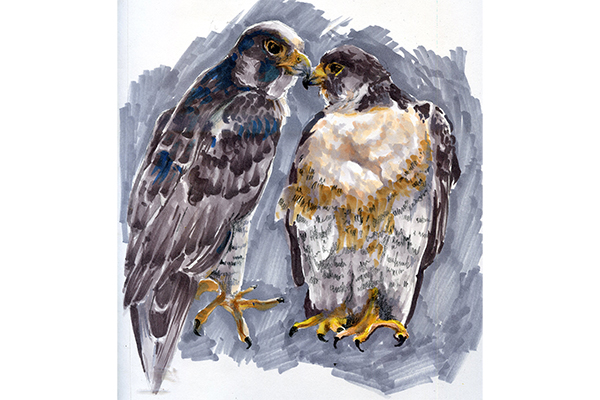Tower Girl, the peregrine falcon that lives in a nest box atop the UT Tower, laid three eggs this past week.
If the group of eggs, called a “clutch,” hatch successfully, they will be Tower Girl’s first successful clutch and the first record of peregrine breeding this far south, said David Hillis, director of UT’s Biodiversity Center.
“The peregrine falcon’s breeding range is mostly north of here, and if this is a successful clutch, it will extend their breeding range a little more to the south,” Hillis said.
Tower Girl has lived on top of the Tower for at least eight years and has tried to lay eggs for several of the past years, Hillis said.
“She laid eggs last year and the year before, but (the eggs) were not fertile,” Hillis said. “There was not a permanent male around those times, so it was not surprising that the eggs were not fertilized.”
The presence of a male is important since they fertilize the eggs, said Jen Schlauch, an undergraduate teaching assistant for the Biology of Birds class.
“Most wild birds lay eggs seasonally, usually in the springtime,” said Schlauch, a biology senior on the ecology track. “But unless a male has mated with Tower Girl, the eggs won’t be fertilized and won’t hatch.”
The male will also help take care of Tower Girl and the eggs, said Phil Butler, a student program coordinator in the College of Liberal Arts who photographs Tower Girl.
“The male will bring food to help Tower Girl eat while she incubates the eggs,” Butler said. “The male also takes part in incubation to give Tower Girl breaks.”
The eggs need to be incubated for about 33 consecutive days, but Tower Girl cannot do it alone, Butler said.
Despite past failures, there have been encouraging signs this year that the eggs will be viable, said Bruce Calder, a UT alumnus who in 2013 requested UT install a nest box for Tower Girl.
“Copulation was observed this year, and that is a big encouragement,” Calder said. “The male looks different from previous males spotted with Tower Girl. He seems more engaged and his presence near and in the box are much more frequent.”
If the eggs do hatch, the young are expected to survive because their natural habitat is a cliff, which the Tower mimics, Hillis said.
“(The peregrines) mostly eat birds, and we have a lot of pigeons on campus,” Hillis said. “They also eat bats, and there are plenty of bats in the Austin area. The Austin campus provides a great place for peregrine falcons to raise the young.”





















